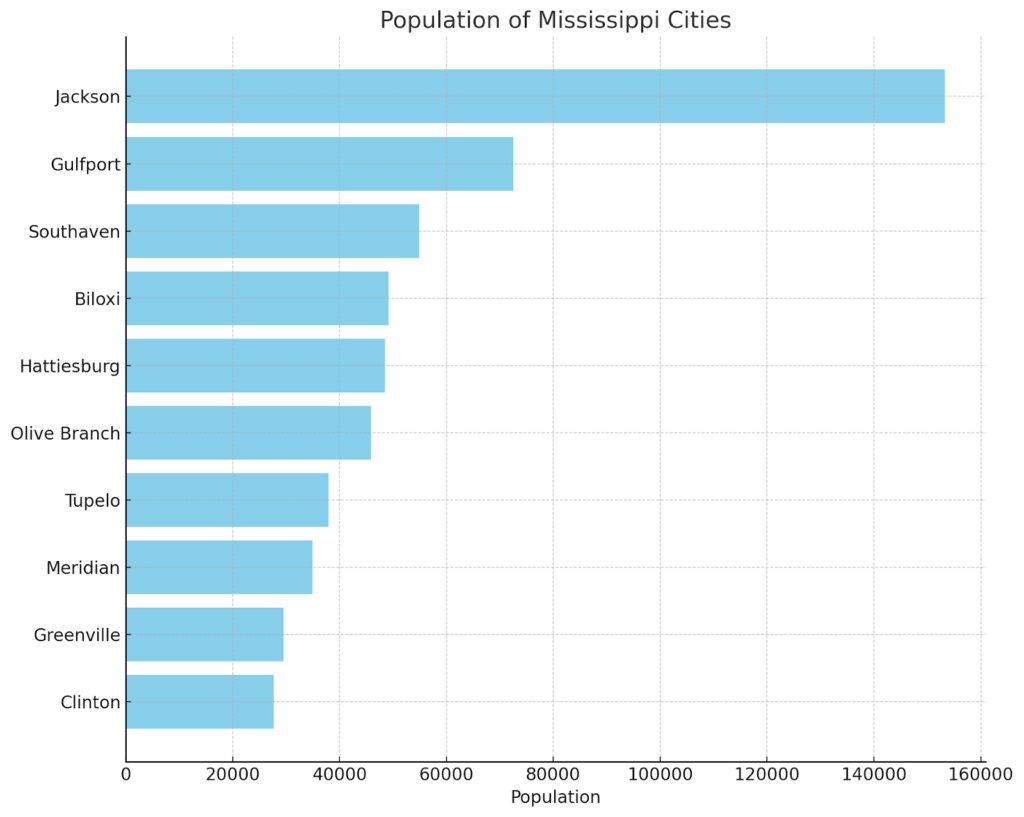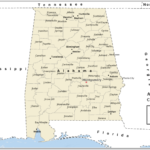Mississippi, a state rich in history, culture, and natural beauty, stands as a testament to the diverse tapestry that is the United States. Known for its significant contributions to the music world, particularly the blues genre, Mississippi also boasts a vibrant agricultural landscape, with cotton, soybeans, and catfish among its leading products. The state’s geography, characterized by the sprawling Mississippi River to the west and the Gulf of Mexico to the south, offers an abundance of scenic views and recreational activities. Amidst this backdrop, Mississippi’s cities serve as hubs of economic, cultural, and social life, each with its own unique charm and character.
What are the Top Mississippi Cities by Population?

1. Jackson
Jackson, the heart and soul of Mississippi, stands as a beacon of cultural richness and historical depth within the state. With a vibrant population of 153,271, it is not only the capital city but also the cultural and political epicenter of Mississippi. Celebrated as the “City with Soul,” Jackson is a treasure trove of musical legacy, brimming with the rhythms of blues, jazz, and gospel that echo through its streets and history. This musical backdrop is complemented by an array of museums, such as the Mississippi Museum of Natural Science and the Mississippi Civil Rights Museum, each offering a window into the state’s diverse ecological and social heritage.
Jackson’s commitment to preserving its history while fostering a dynamic arts scene is evident in its numerous galleries, live music venues, and cultural festivals. These elements collectively underscore Jackson’s role as a crucial cultural hub, where the spirit of Mississippi’s past and present converges. The city’s dedication to civil rights and its rich artistic tapestry make it an indispensable part of the state’s identity, offering residents and visitors alike a place where history, culture, and community flourish.
2. Gulfport
Gulfport, Mississippi’s picturesque gateway to the Gulf of Mexico, plays a pivotal role in the state’s landscape, both geographically and culturally. Housing a population of 72,524, it stands as Mississippi’s second-largest city, thriving as a vital economic and cultural hub. Its extensive coastline is not just a testament to natural beauty but also underpins the city’s bustling seafood industry, with shrimping and fishing at its heart. Beyond its economic contributions, Gulfport has emerged as a beloved tourist haven, drawing visitors to its pristine beaches, vibrant casinos, and family-friendly attractions like the Gulf Islands Waterpark.
The city’s remarkable recovery and revitalization efforts in the aftermath of Hurricane Katrina in 2005 have showcased an unparalleled community resilience and spirit. Gulfport’s journey from devastation to rejuvenation exemplifies its strength and unity, making it a symbol of hope and rebirth in the face of adversity. This enduring spirit, coupled with its natural beauty and economic vitality, cements Gulfport’s status as a cornerstone of Mississippi’s cultural and economic identity.
3. Southaven
Southaven, nestled in the northern reaches of Mississippi and a key component of the Memphis metropolitan area, embodies a unique blend of southern charm and urban sophistication. With its population of 54,908, the city offers an appealing mix of residential tranquility and metropolitan accessibility. Southaven is distinguished by its robust retail landscape, verdant parks, and state-of-the-art recreational amenities, epitomized by the BankPlus Amphitheater at Snowden Grove. This venue is a cultural hotspot, hosting a plethora of concerts and events that draw both locals and visitors.
The city’s strategic location near Memphis enhances its allure, providing easy access to a rich tapestry of cultural, historical, and entertainment options. This proximity, however, does not detract from Southaven’s distinct, close-knit community vibe. It strikes a perfect balance, offering the best of both worlds: the serenity and warmth of small-town life, coupled with the vibrancy and convenience of city living. This harmonious blend makes Southaven a coveted destination for those seeking a comprehensive living experience, combining the best aspects of southern hospitality and urban dynamism.
4. Biloxi
Biloxi, home to 49,141 people, is a city with a rich history and a strong connection to the Gulf of Mexico. It is renowned for its casinos, fishing, and the Biloxi Lighthouse, one of the oldest standing lighthouses in the United States. The city’s economy thrives on tourism, gaming, and seafood industries. Biloxi also has a significant military presence, with Keesler Air Force Base located within the city. The resilience of Biloxi’s community is evident in its recovery from the devastation of Hurricane Katrina, showcasing a spirit of revival and strength.
5. Hattiesburg
Hattiesburg, known as “The Hub City,” has a population of 48,466 and serves as a key center for education, healthcare, and the military in Mississippi. The city hosts the University of Southern Mississippi, which is a significant contributor to its vibrant culture and economy. Hattiesburg’s historic neighborhoods, combined with its commitment to the arts and education, make it a lively community. The city’s location at the intersection of six major highways underscores its role as a transportation and commercial hub in the southern United States.
6. Olive Branch
Olive Branch’s metamorphosis from a quaint farming village to a bustling suburban city mirrors the broader growth trends in the Memphis metropolitan area. Today, with a population of 45,938, it stands as one of Mississippi’s fastest-expanding cities, a testament to its allure for families and businesses alike. The city’s infrastructure, characterized by high-quality education systems, sprawling parks, and a variety of residential and commercial offerings, caters to a diverse community seeking a blend of suburban tranquility and urban convenience. The Olive Branch City Park, a hub of greenery and recreation, epitomizes the city’s commitment to fostering community spirit and active lifestyles. This dynamic growth reflects not just the city’s adaptability and appeal but also its residents’ pride in creating a vibrant, inclusive community. Olive Branch’s evolution showcases the city’s successful balancing act between preserving its pastoral heritage and embracing modern development, making it a prime example of Mississippi’s potential for suburban excellence.
7. Tupelo
Tupelo, the birthplace of Elvis Presley, has a population of 37,939. This city is steeped in cultural and historical significance, with the Elvis Presley Birthplace & Museum attracting fans from around the world. Tupelo is also known for its role in the civil rights movement and its vibrant downtown area, which hosts festivals, concerts, and other community events. The presence of the Natchez Trace Parkway, a scenic road rich in history, adds to the city’s allure as a destination for history buffs and nature lovers alike.
8. Meridian
Meridian, with its 34,990 residents, is not just a city; it’s a vibrant cultural hub that pulsates with the rich tapestry of eastern Mississippi’s heritage. Renowned for its dynamic arts scene, it is home to the Mississippi Arts + Entertainment Experience (The MAX), a state-of-the-art museum that celebrates Mississippi’s global contributions to the arts. Additionally, the historic Riley Center, a beautifully restored opera house, stands as a beacon of performing arts, drawing audiences for high-caliber performances. Meridian’s identity is deeply intertwined with its musical heritage, particularly in genres like country and gospel, reflecting the soul of its community. This commitment to preserving its historical roots, while simultaneously embracing cultural evolution, positions Meridian as a city where the past and present harmoniously blend. Through festivals, museums, and live performances, Meridian fosters an environment where arts and culture flourish, making it a cornerstone of Mississippi’s cultural landscape.
9. Greenville
Greenville, with a population of 29,495, is located in the heart of the Mississippi Delta and is known for its deep roots in blues music, agriculture, and the arts. The Greenville Blues Festival is a testament to the city’s musical heritage. Additionally, Greenville’s location along the Mississippi River contributes to its identity and economy, with the river providing recreational and commercial opportunities. The city’s dedication to celebrating its culture and history is evident in its museums and cultural centers.
10. Clinton
Rounding out the list with 27,668 residents, Clinton is a city that offers a blend of historical charm and modern living. It is known for its excellent educational institutions, including Mississippi College, the oldest college in the state. Clinton’s vibrant downtown area, community events, and well-maintained parks provide a high quality of life for its residents. The city’s efforts to preserve its history while promoting growth and innovation exemplify its balanced approach to development.
Mississippi’s cities, each with its distinct personality and contributions, collectively showcase the state’s diversity and resilience. From the bustling streets of Jackson to the quiet charm of Clinton, Mississippi offers a rich tapestry of experiences for residents and visitors alike. These cities, with their unique blend of history, culture, and community spirit, stand as pillars of the Magnolia State’s enduring legacy.
Last modified: February 29, 2024

